In 1953, the Netherlands Christian Homes for the Deaf and Stupid (NCBD) established the Christian Homes for the Deaf and Stupid. Money had been raised from the NCBD for many years and the new foundation eventually bought a villa in Baarn where Deaf Joy was established, an institution for the deaf. The success of this institute proved to be such that at a certain point there was just a waiting list for this home. The popularity of the Deaf Joy in the purchase of a new (and replacement) house in 1972 in Ede, called De Gelderhorst. Nowadays, De Gelderhorst is located at a different location in Ede.
Deaf joy in 1953
Dovenvreugd in Baarn, 1953.
Foto: Archief Eemland, B-II-000135.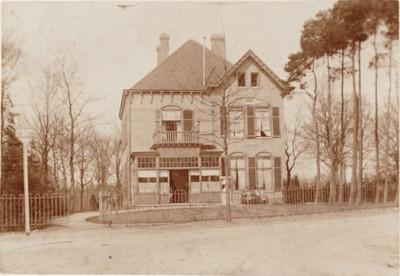
The financial support for the purchase of this villa came from the NCBD. The central government did not help with the financing. Part of the purchase amount therefore came from the deaf money collection. The deaf actively raised money by collecting paper and capsules. Unfortunately, the future residents did not have enough money back then, so there was also financial support from municipal authorities and diaconia and from society in the form of donations. In 1953 the members of the NCBD had the above villa in mind. So they came together, and the remaining money was collected. In the end there was enough to take out a mortgage; Joy of the deaf could start.
The tendency around Deaf people at founding
Artikel over de opening van Dovenvreugd.
Trouw, 8 juli 1953.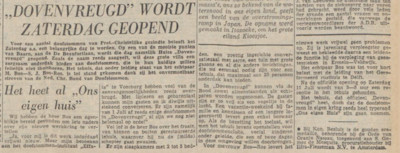
Deaf Joy was founded at a time when the Netherlands was pillarized and was therefore only intended for Protestant Christians. The above-mentioned newspaper article from the 1953 Wedding shows the negative and unjustified picture with regard to the deaf. From quotes such as: "Deaf and mute people who do not actually belong in their current environment" and "For Mrs. Bos-Ros (supervisor) the new work presents virtually no problems with her experience as a nurse and supervisor in nursing the mentally ill "that the deaf were often referred to and treated as patients. In the interview we had with Mrs. Barry Vogelaar, chairman of the NCBD, it became clear that many deaf people do not see themselves that way and that they are not.
I really don't see it as a limitation at all. It really is a part of my identity. Deaf power!
Ms. Vogelaar said.
In addition to the clear picture that the deaf existed in the second half of the twentieth century, it is clear from the newspaper that Deaf Joy was above all intended to facilitate the lives and living conditions of deaf people. The following quote is exemplary here. "There are bedrooms with 2 to 5 beds, a pleasantly decorated conversation room with conservatory, a garden with large lawns and all those other arrangements that are simply needed for a home that can accommodate up to 25 people."
Vacature voor Dovenvreugd.
Trouw, 08 augustus 1957.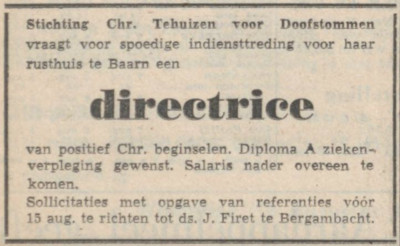
It is also clear from this vacancy from the Trouw of 1957 that there was a preference for someone with a Diploma A nursing for the position of director. In addition, a Christian person was asked, from which it can be determined how poor the society was at that time.
Living in Dovenvreugd
The purpose of the Foundation for Christian Homes for the Deaf, which was set up by the NCBD, was to accommodate the elderly deaf and dumb who were mentally and physically disabled. Not only deaf elderly people, but also families or deaf people could live in Deaf Joy. For example, the large garage was used as a place to stay for youth clubs or the deaf and dumb. In short, Deaf Joy was also part of a larger plan. The residential function of Dovenvreugd had a strong social aspect: combining the loneliness of the deaf. However, at a certain point in time Deaf Joy grew so fast that the growth was at the expense of the privacy and hygiene of the residents. Mrs Vogelaar said in the interview:
Everyone was together every day and sat close together and there were irritations and complaints. It was also not good for hygiene and fire safety.
Slaapkamer in Dovenvreugd.
Foto: NCBD archief van Barry Vogelaar. Slaapkamer in Dovenvreugd.
Foto: NCBD archief van Barry Vogelaar. 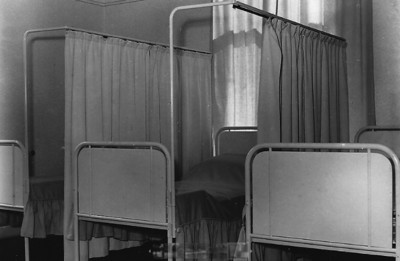
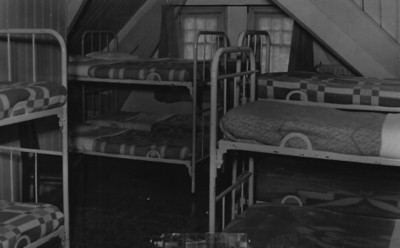
The curtains, as seen above between the beds, offered no privacy according to current privacy standards. The design of the bedrooms with bunk beds ensured that people lived close together.
Below you can see that there was little room to sit together at the table. In addition, the table was rectangular, making communication (including gestures) between residents difficult.
Eetkamer in Dovenvreugd.
Foto: NCBD archief van Barry Vogelaar.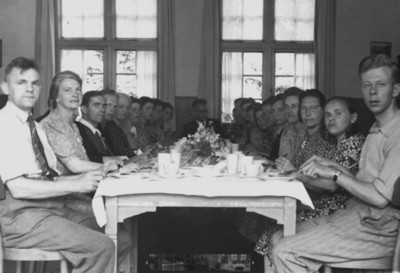
The emancipation of the deaf
Voorkant van het Bondsblad van de NCBD.
NCBD archief van Barry Vogelaar.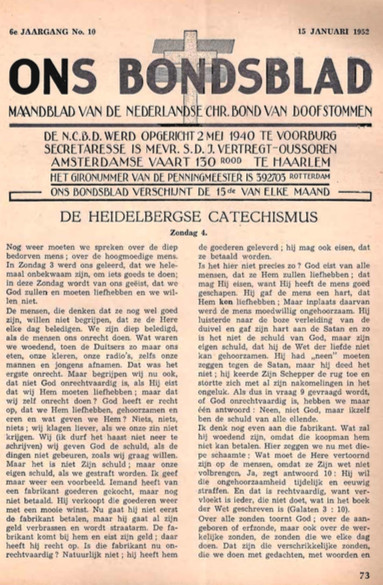
From 1946, the NCBD published its own magazine: Ons Bondsblad. This magazine had to take over the contact and information task from the Effatha leaf (the magazine of the school for the deaf Effatha). S. Vertregt-Oussoren then did the final editing of this magazine at the time. She was a teacher at the Reformed Institute and she was also a secretary of the NCBD. The magazine included religious reflections, world news and news from the (departments of the) NCBD. The magazine also contained association news and other national and international news that related to the deaf. At the cradle of this magazine was an editorial team consisting of teachers from the Reformed Institute. It was striking that these were mostly hearing people. Only a few were deaf within the editors.
The transition from Dovenvreugd to De Gelderhorst
What used to be Dovenvreugd in Baarn is today the Gelderhorst in Ede.
Where about 20 people could live in Dovenvreugd, there were a lot more in De Gelderhorst.
In 1972, at a time when more money was possible from the NCBD and the demand for housing from the deaf community grew, a house was purchased in Ede where about 103 deaf people could live. However, this house had a rectangular shape, making communication between the deaf difficult.
In 1997, De Gelderhorst therefore moved to a building that had a U-shape, so that the deaf could sit at a table at the table, but also so that the deaf could sign to each other from different parts of the building.
De Gelderhorst is still in this building today.
The Gelderhorst
The social aspect of living in De Gelderhorst
Youtube-fragment, De Gelderhorst, circa 1992.
The above youtube fragment is illustrative of the (social) importance of De Gelderhorst. The quotes below of some residents are meaningful.
Here you are with the deaf. Cozy. Hearing and deaf people together in a retirement home is wrong. Then we are lonely.
Hearing people do not always have the patience to talk to the deaf.
Mrs Vogelaar also emphasized in the interview the social consequences that De Gelderhorst can have. Vogelaar's mother first lived independently in Zuilichem. She felt alone there, so she moved to De Gelderhorst in 1998/1997. She went to live in a sheltered home, so not yet in the actual care home. Vogelaar's mother made many new friends and made many trips. The social function of De Gelderhorst therefore once again dominated.
The practical aspects of living in De Gelderhorst
Another important quote from the youtube excerpt shown above is:
Lamps have an important function: fire alarm, doorbell, coffee. Mass with gestures.
Mrs Vogelaar also told us about this. Her house contains similar adjustments to her deafness. She has flashlights in her house that indicate different things with different colors of light. Orange flash light is the sign that her phone rings, red flash light is the sign that the fire alarm goes off and white flash light is the sign that the doorbell rings. The baby monitor used to provide a different color of flash light when her daughter was young. Vogelaar also has a special vibration system for when its alarm goes off. The independence, but even the safety, of a deaf person is improved by these kinds of adjustments. That these functions also exist within De Gelderhorst indicates once again how important such a home is for the deaf.
Youtube-fragment, De Gelderhorst, 2017.
This youtube video is also illustrative of the situation as it is today in De Gelderhorst.
The buildings are round to let in as much light as possible: that makes communication easier!
The current location of De Gelderhorst was officially opened on 22 April 1998 by Queen Beatrix on Willy Brandtlaan in Ede. It is an impressive building, which is characterized by the round shapes and the large amount of daylight that enters through the large number of glass walls. The Gelderhorst is therefore not only striking to see, but it is also a very functional building that gives residents the opportunity to communicate with gestures as effectively as possible. Examples include communicating from the fifth floor to the ground floor.
The future Gelderhorst
In conclusion, it is still significant to mention that Barry Vogelaar answered the question "Would you like to live in De Gelderhorst when you are elderly?"
Hell yes! I don't want to think about going to a hearing home for the elderly. Then I should walk on my toes. I just want to be able to chat. When I see someone at a distance through a window, I just want to be able to communicate nicely. There is a very long waiting list at De Gelderhorst, as many as one hundred and ten people. I am already on it, but at the bottom unfortunately ...
Vogelaar therefore told us with a happy tone that a new section is now being built on De Gelderhorst. De Gelderhorst is now in a U-shape, but a new section will be added so eighty people can live with it. The first pile went into the ground in September and work is already underway on the first floors. The new part will be officially delivered in 2020.
It is important that the Gelderhorst continues to exist, because it is, in addition to a few similar smaller institutions in Europe, a unique healthcare institution with great importance for the (deaf) community.
On to even more Geldervreugd ...
Eva Bakels, Barry Vogelaar en Loek Zoon.
Foto: Willeke Kreling.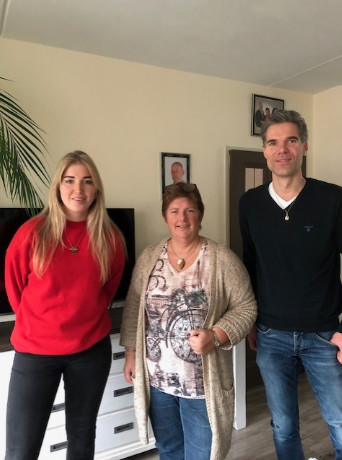
Thanks to:
Barry Vogelaar
Corrie Tijsseling
Written by:
Eva Bakels and Loek Son